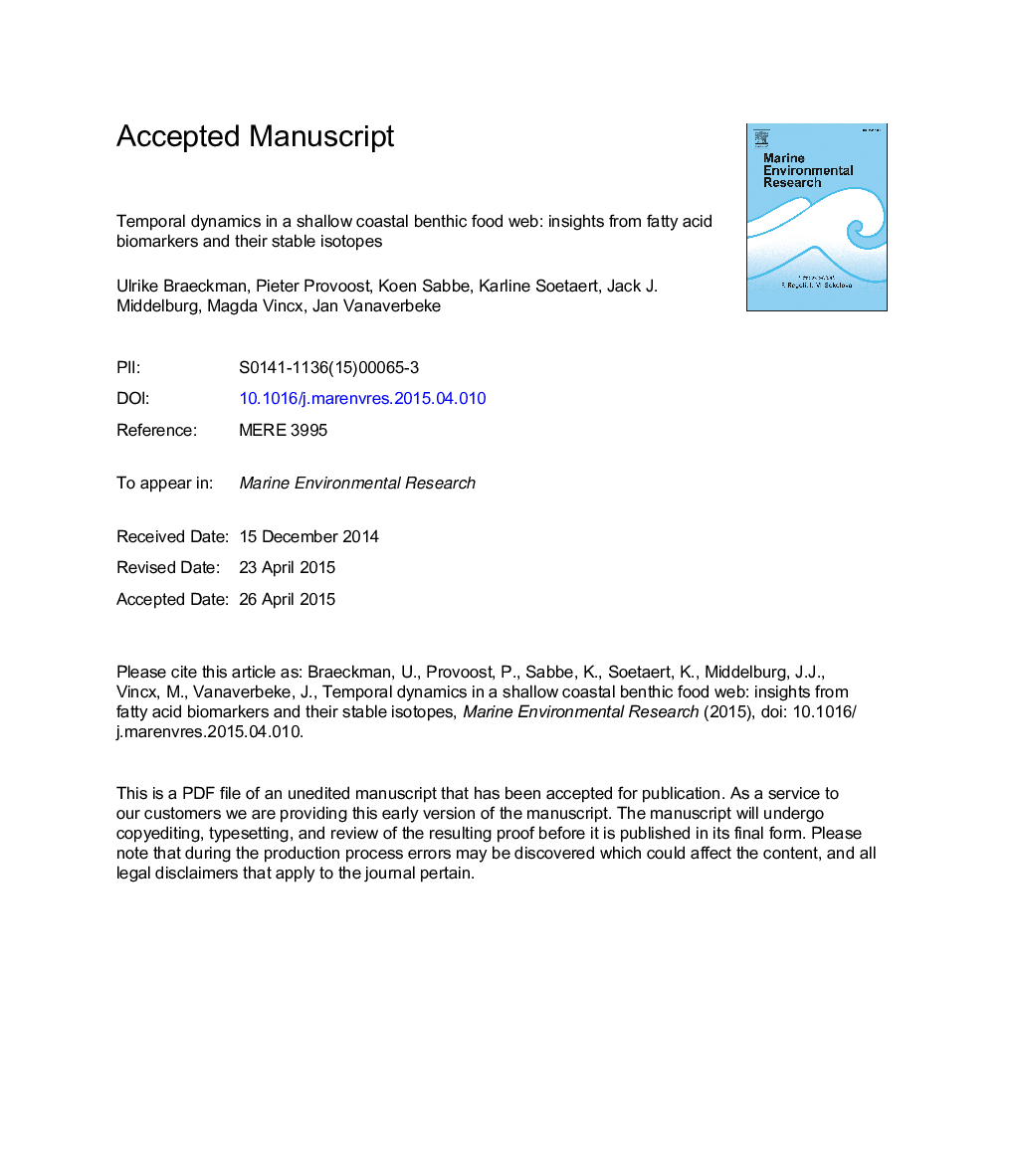| کد مقاله | کد نشریه | سال انتشار | مقاله انگلیسی | نسخه تمام متن |
|---|---|---|---|---|
| 6387759 | 1627574 | 2015 | 41 صفحه PDF | دانلود رایگان |
عنوان انگلیسی مقاله ISI
Temporal dynamics in a shallow coastal benthic food web: Insights from fatty acid biomarkers and their stable isotopes
ترجمه فارسی عنوان
دینامیک زمانبندی در یک وب سایت غذای کم عمق ساحلی: نگاهی به بیومارکرهای اسید چرب و ایزوتوپ پایدار آنها
دانلود مقاله + سفارش ترجمه
دانلود مقاله ISI انگلیسی
رایگان برای ایرانیان
کلمات کلیدی
نماتدها، ماکروبنتوز، شکوفه فیتوپلانکتون، ترکیب اسید چرب، پارتیشن بندی منابع، رقابت،
موضوعات مرتبط
مهندسی و علوم پایه
علوم زمین و سیارات
اقیانوس شناسی
چکیده انگلیسی
We investigated the temporal variation of pelagic and benthic food sources in the diet of benthic taxa at a depositional site in the Southern Bight of the North Sea by means of fatty acid (FA) biomarkers and compound-specific stable isotope analysis (CSIA). The taxa were the non-selective deposit feeding nematodes (Sabatieria spp. and 'other nematodes'), and three dominant macrobenthic species: two true suspension-deposit feeders (the bivalve Abra alba and the tube dwelling polychaete Owenia fusiformis) and the suspected predatory mud-dwelling anemone Sagartia sp. These species make up on average 16% (Abra alba), 17% (Sagartia sp.) and 20% (Owenia fusiformis) of the biomass in the Abra alba-Kurtiella bidentata community in this area. Phytoplankton dynamics in the suspended particulate matter of the water column as inferred from cell counts, chlorophyll-a and organic carbon content were clearly visible in sediment and animal FA abundance as well, whereas phytodetritus dynamics in the sediment FA composition were less clear, probably due to patchy distribution or stripping of FA by macrofauna. Nematodes appeared to assimilate mainly Polyunsaturated Fatty Acids (PUFAs) from their sedimentary environment and were further non-selectively accumulating more (Sabatieria spp.) or less ('other nematodes') FA from the deposited phytodetritus. In contrast, Abra alba FA composition was consistent with a diatom-dominated diet and consumption of Phaeocystis was observed in Owenia fusiformis, whereas Sagartia sp. showed evidence of a predatory behaviour. While the total FA content in Owenia fusiformis remained constant throughout the year, Sagartia sp. doubled and Abra alba increased its FA level more than 10-fold in response to the organic matter deposition from the phytoplankton bloom. This leads to the conclusion that there is no resource partitioning between non-selective deposit feeding nematodes and the suspension-deposit feeding macrobenthic organisms, suggesting they belong to separate parts of the benthic food web.
ناشر
Database: Elsevier - ScienceDirect (ساینس دایرکت)
Journal: Marine Environmental Research - Volume 108, July 2015, Pages 55-68
Journal: Marine Environmental Research - Volume 108, July 2015, Pages 55-68
نویسندگان
Ulrike Braeckman, Pieter Provoost, Koen Sabbe, Karline Soetaert, Jack J. Middelburg, Magda Vincx, Jan Vanaverbeke,
